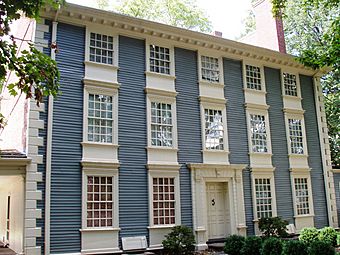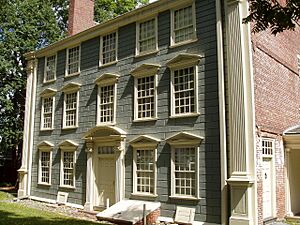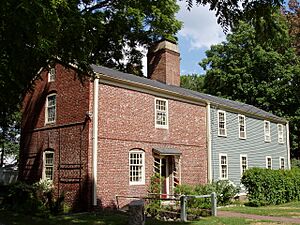Royall House and Slave Quarters facts for kids
|
Isaac Royall House
|
|

East (front) facade, built by Isaac Royall Sr. over the original farmhouse
|
|
| Location | 15 George Street, Medford, Massachusetts |
|---|---|
| Built | 1732 |
| Architectural style | Georgian |
| NRHP reference No. | 66000786 |
Quick facts for kids Significant dates |
|
| Added to NRHP | October 15, 1966 |
| Designated NHL | October 9, 1960 |
The Isaac Royall House and Slave Quarters is a very old house in Medford, Massachusetts. It is close to Tufts University. This historic place was started by Isaac Royall, who was from the Massachusetts Bay Colony. It helps us understand the history of slavery and the lives of enslaved people in Massachusetts.
This house is a National Historic Landmark. It is now a museum run by a non-profit group. You can visit it from June 1st until the end of October. The Royall House is special because it is very well-preserved. It also has the only remaining slave quarters in Massachusetts. It is connected to the American Revolution and famous people like General John Stark, Molly Stark, and General George Washington.
Inside, you can see interesting historical items. One is a tea box, which people say came from the same tea that was thrown into Boston Harbor during the Boston Tea Party in 1773. There is also a small painting of Isaac Royall Jr. by John Singleton Copley. The Royall family owned more enslaved people than any other family in Massachusetts history.
Contents
Building the Royall House
The land where the house stands was first given to Governor John Winthrop in 1631. However, he probably did not build a house there. The main part of the house we see today was built around 1692. It was a strong brick building, two and a half stories tall. Its walls were very thick.
On December 26, 1732, Isaac Royall Sr. bought the house and a large piece of land. He was a rich merchant who traded enslaved people and made rum in Antigua. Between 1733 and 1737, he made many changes to the house. He added a third story and covered the front with wooden boards. He also added fancy decorations to the outside.
In 1732, Royall Sr. also built other buildings. These included the only known separate slave quarters that still exist in New England. After building these, he brought 27 enslaved Africans from Antigua. This doubled the number of enslaved people in the area.
Changes by Isaac Royall Jr.
Isaac Royall Jr. took over the property in 1739 after his father passed away. He made the house much bigger between 1747 and 1750. He added more depth to the main building and built large chimneys on each end. He also added decorative siding to the new back of the house.
The inside of the house was also updated. It was decorated in the Georgian style with beautiful wooden panels and archways. Many of the main rooms you see today are original. Isaac Royall Jr. turned a colonial farmhouse into a grand three-story mansion. It was considered one of the most impressive houses of its time in North America.
Paintings of Isaac Royall Jr.'s daughters, Mary and Elizabeth, were made by John Singleton Copley around 1758. A copy of this painting hangs in the Royall House. Copley also painted Isaac Royall Jr.'s portrait around 1769.
The American Revolution and the Royalls
During the American Revolution, the Royall family were Loyalists. This meant they supported the British King. After fighting started in 1775, the Royalls left Medford. They sailed to Halifax, Nova Scotia, and then to England. Isaac Royall Jr. never came back to Medford.
After the Royalls left, the government of Massachusetts took over their estate. General John Stark used the Royall House as his headquarters. This was before the British left Boston on March 17, 1776. The mansion was also used as the headquarters for George Washington's second-in-command, Charles Lee. Lee jokingly called it "Hobgoblin Hall."
There is a story that Washington questioned two British soldiers in the house's Marble Chamber. Another story says that Molly Stark watched British troops from the roof. However, there are no official records to prove this.
In 1806, the estate was given back to Isaac Royall's family. They sold it. Isaac Royall's will also set aside money for Harvard University. This money was used to start Harvard Law School.
The Slave Quarters
The Slave Quarters building was located about 35 feet from the main Royall House. Over 60 enslaved Africans lived there during a 40-year period.
When Isaac Royall Sr. expanded the main house in the 1730s, he built an "out kitchen." This was a separate kitchen building. It was a common practice in the Caribbean to keep the heat from cooking away from the main house in summer. In the 1760s, a wooden addition was built onto this kitchen. This addition became the original slave quarters.
The Slave Quarters had areas for working and sleeping. There was a "kitchen chamber" on the second floor where enslaved people worked and slept. Visitors can see this room during tours of the Royall House today.
One of the enslaved women from the Royall House was named Belinda Sutton. She is famous for asking the court for money from the Royall family's estate. Her request is seen as one of the earliest examples of people seeking reparations for slavery in the United States.
Saving the House
In 1898, a group called the Sarah Bradlee Fulton Chapter of the Daughters of the American Revolution wanted to save the Royall House. They wanted to preserve it because of its history and beauty. The house was restored by Joseph Everett Chandler. On Patriots' Day in 1898, they opened the house to the public. They showed old furniture and valuable historical items.
In 1906, this group of women formed the Royall House Association. Their first goal was to raise $10,000 to buy the house, the slave quarters, and some land around it. They wanted to keep it as a museum. They achieved this goal by April 1908.
Over the years, the Royall House has been restored many times, both inside and out. In 1960, the Royall House was named a National Historic Landmark.
In 2023, Harvard Law School and the Royall House and Slave Quarters made an agreement to work together. This included financial support from the school. It is one way the school is honoring the work of enslaved people who helped build Harvard University.
See also








